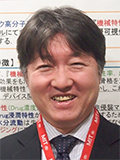Newsletter 2019.2 Index
Theme : "Mechanical Engineering Congress, 2018 Japan (MECJ-18)"
|
Application of multi-functional OCT to diagnose skin mechanics ~Visualization of skin vasculature~
Yusuke HARA |
Abstract
Skin is a thin tissue whose thickness is approximately 2 to 3 mm. It covers the entire human body and, despite its thinness, the skin’s total weight actually accounts for 16% of a person’s total weight. This makes skin the largest organ in the human body. It essentially has two layers, the epidermis and dermis, and consists of many components, such as blood vessels, lymph vessels, sweat glands, and others. Since the skin is the boundary between the living body and the outside world, it plays an extremely important role in the maintenance of life, such as performing the barrier function, adjusting body temperature, and many others. It is well known that malfunctioning skin directly leads to appearance troubles, such as wrinkles and aging spots, as well as diseases and disorders related to quality of life and beauty. Therefore, diagnosing the various functions of the skin with high accuracy is important in not only the medical field but also the cosmetic industry.
To evaluate skin structure, Optical Coherence Tomography (OCT) has recently been developed and its clinical application is being studied. OCT can obtain sectional images of the skin in vivo non-invasively with a high spatial resolution from 1 to 10 μm at a speed higher than the average video rate. In this study, we focused on the possibility of extending the OCT’s functionality. We successfully developed a novel technology which can visualize the skin’s vasculature using OCT and investigated its application to facial skin.
Key words
Facial skin, Optical Coherence Tomography, Vasodilation effect
Figures

Fig. 1 Vasodilation effect of blood circulation promoter.
Blood vessel images before and after application of benzyl nicotinate are shown in (a) and (b), respectively.
White regions indicate the blood vessels.



